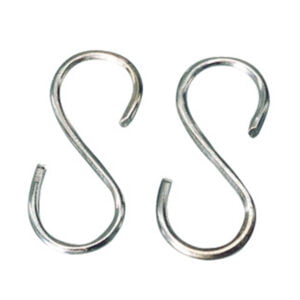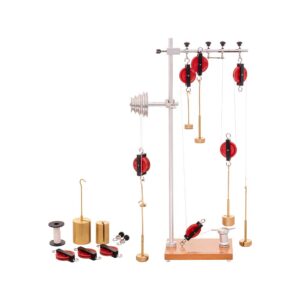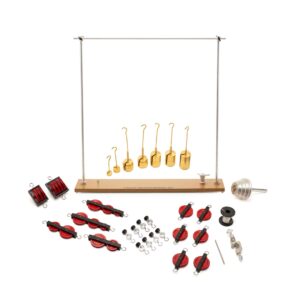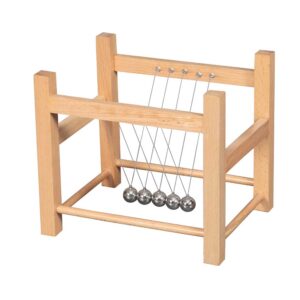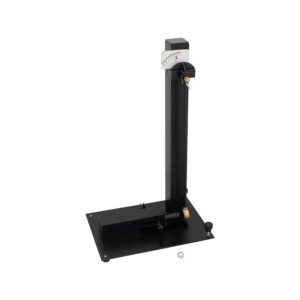Physics
-
Mechanics
Wheel and Axle
13 cm diameter molded wheel contains 4 grooves of different diameters in the ratios 1, 3, 5 & 7. The grooves are wide and flat bottomed ensuring an exact diameter for each groove, each comes with a small hole to retain the cord. The back of the wheel is hollow to minimize the mass and inertia. Wheel is attached to a 14 cm long rod.
PH10400 -
Mechanics
Student Pulley Set
Used to demonstrate the concepts of force and mechanical equilibrium. Contains a polished wooden base with a capstan mounted at one end and screw eye for hanging pulleys at the other, 24″ vertical support rod, 8″ crossbar with clamp, 8 single pulleys, 2 double pulleys, wheel and axle, 6 pulley clamps, 90° clamp, 9 hooked masses ranging from 10 to 1,000 g, pulley cord, and instructions.
PH10401 -
Mechanics
Pulley Demonstration Set
The Pulley Demonstration Set is designed to illustrate the working principle of simple machines. From the wheels on a bicycle to the gears in a car, the Pulley Demonstration System helps explain how things work. It helps student to understand the concepts of the mechanical advantage, the efficiency of fixed and moveable pulleys etc. Students perform quantitative experiments on fixed and moveable pulleys, trains of fixed and moveable pulleys, the wheel and axle and the capstan etc.
The set includes:
- Wooden base includes Size – 81 x 20 cm. capstans, sockets (2) and an eye hook.
- Rods : 3 (Dia. – 12.5 mm x L- 81 cm).
- Collars with hook: 8
- Right-angled clamps : 3
- Wheel axle: 1
- Bar for tightening vertical rods: 1
- Masses: Slotted brass weights. 2×10 gm, 2×20 gm 2×50 gm, 4×100 gm, 4×200 gm, 1×500 gm Total 15 weights.
- Weight hangers: Brass hangers 5×50 gm, 1×20 gm, 1x 10 gm.
PH10402 -
Mechanics
Projectile Apparatus
(Falling Body Apparatus) Showing that horizontal and vertical motions are independent of each other. Consists of a wooden block 190 x 58 x 30 mm approx. with a pivoted L-section spring loaded metal launching bar with a trigger catch. On releasing the catch, one steel ball drops vertically while the other is projected horizontally, both hitting the floor at the same time. Supplied with 2 steel balls with storage recess in the block.
PH10405 -
-
-
Mechanics
Projectile Launcher
For exploring the projectile motion and trajectories. With a release latch that can be adjusted and locked in any desired setting, Supplied with two drilled balls, attached protractor and plumb bob for determination of angle of inclination. Includes a clamp to fasten the apparatus to a tabletop. With Instructions.
PH10412 -
Mechanics
Marble Launcher
Durable apparatus to study velocity, acceleration, and projectile motion. Marbles can be launched from five different speeds at any angle between 0 and 90°.
Velocity of the marble can range from 3 m/s to 9 m/s. Easy-to-read protractor allows for precise measurements and calculations. Sturdy hardwood construction is built to last. Includes a detailed instruction guide and two marbles.
16″ L x 10″ W x 12½” H.
PH10414 -
Mechanics
Second Law of Motion Apparatus
To demonstrate the Second Law of Motion simply and accurately, two identical balls-one drilled, and the other solid is used. When the release lever is triggered, the internal spring accelerates one ball and releases the other, showing that two balls dropped from the same height hit the ground at the same time even though one is traveling forward when the balls are released. Support stand and clamp required, but not included. With instructions.
PH10415 -
Mechanics
Energy Transformation Balls
Demonstrates conversion of kinetic energy into heat and sound energy during a collision. Consists of a pair of heavy steel balls. When the balls strike against each other with a piece of paper between the balls, the heat causes a hole to appear in the paper. The kinetic energy of the balls upon collision is converted to heat which is sufficient to burn a hole in the paper. With instructions.
PH10416 -
Mechanics
Pendulum Waves
In this apparatus, you will use the laws of simple pendulum motion to create a pendulum wave apparatus: a device where many pendulums of different lengths, and therefore different periods, start swinging at the same time. As they move in and out of sync, the pendulums create a sequence of cycling visual wave patterns.
PH10420 -
Mechanics
Ballistic Pendulum Apparatus
This apparatus is designed to clearly illustrate the principles of momentum conservation and the behavior of projectiles. It features a robust and stable base, complemented by a precision-mounted vertical pendulum. The pendulum is equipped with a specially designed pocket that securely holds a ball in a rubber ring, ensuring it remains in place upon impact. The setup allows accurate measurement of the pendulum’s deflection angle, enabling precise calculations of momentum transfer and trajectory. Constructed for durability and ease of use, the apparatus comes complete with a comprehensive instruction manual for guided experimentation.
PH10422



